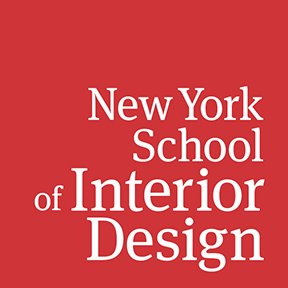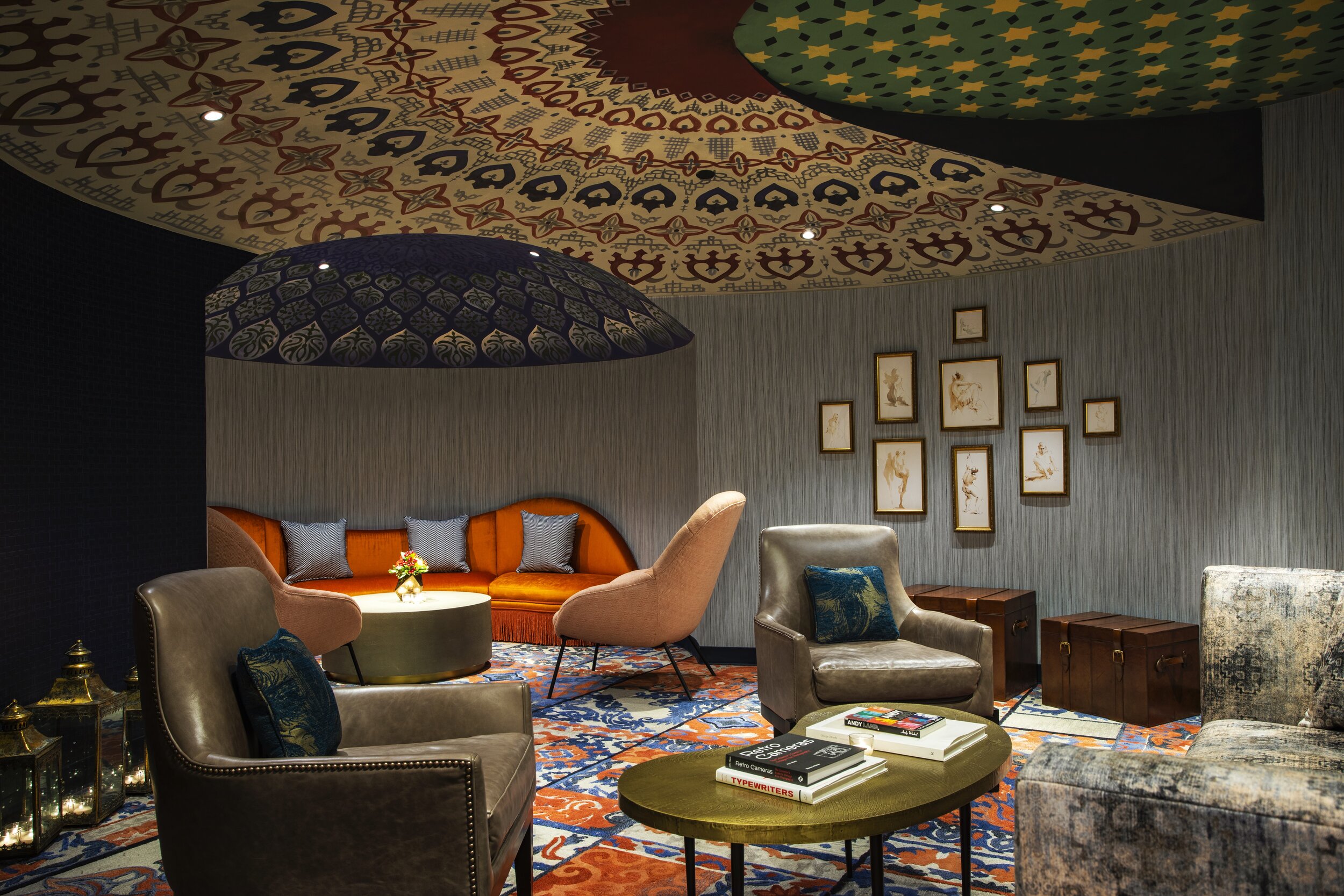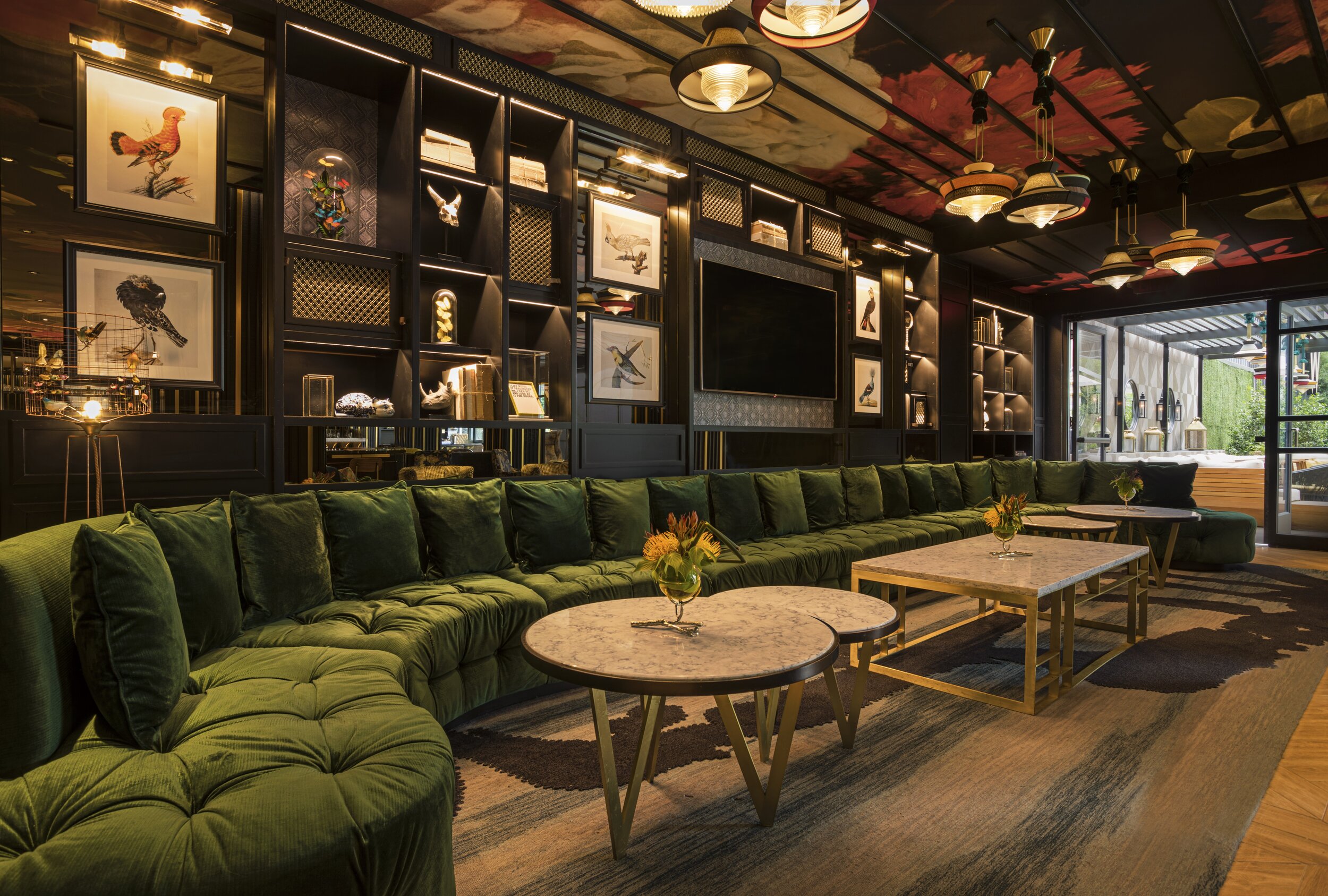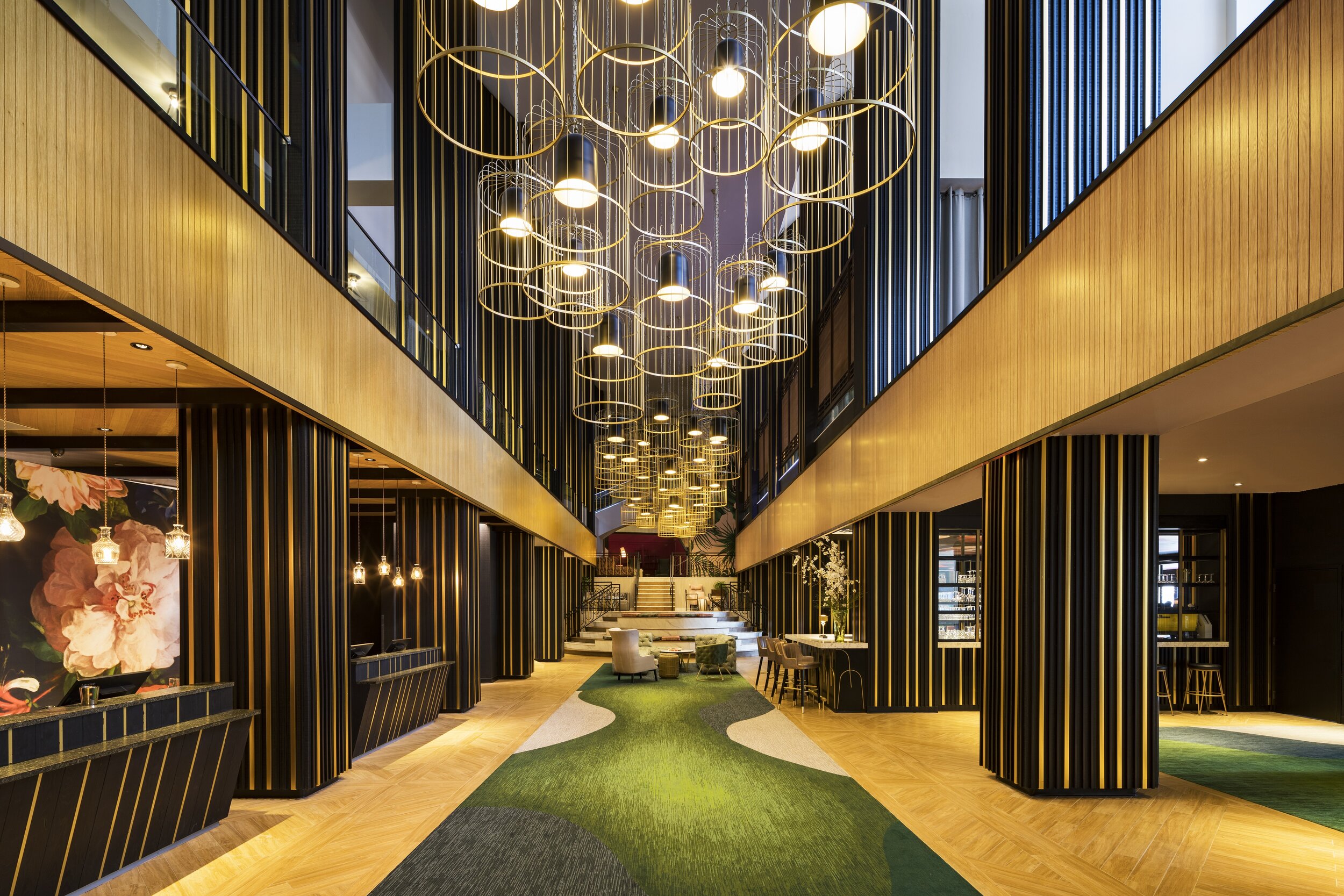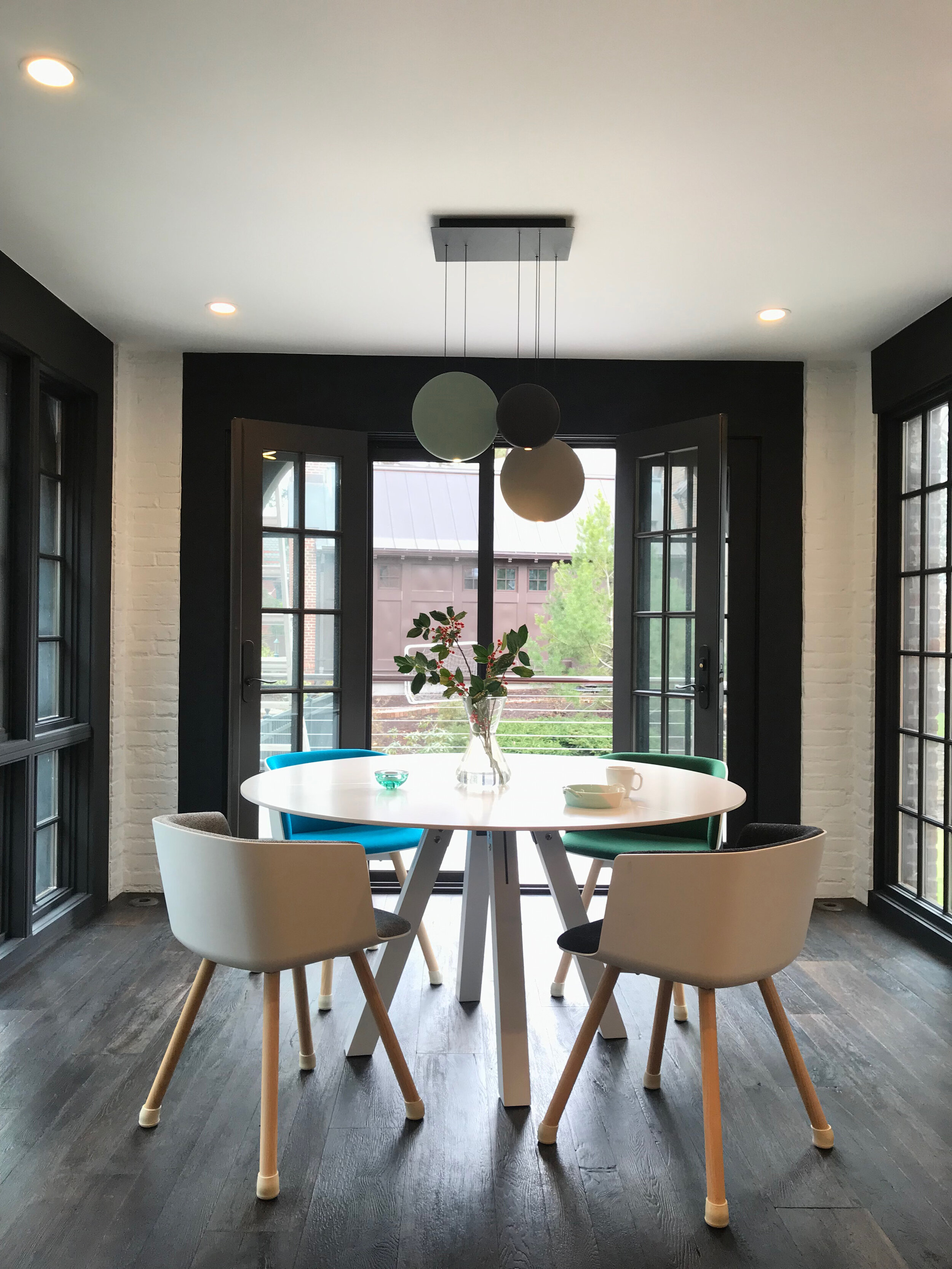Design is a Global Language
Five International Alumni on Forging Dynamic Careers in the US
NYSID alumni Therese Virserius ’03 (AAS), founder / owner, Virserius Studio; Jennifer Graham ’85 (BFA), principal, Perkins&Will; Ruoxi Cui ’13 (MFA1), interior designer, WRNS Studio; Ilya Pulyaev ’17 (MFA2), interior project designer / associate, Perkins&Will and NYSID instructor; and Myoung Joo Chun ’02 (MFA2), director of graduate interior architecture, Endicott College / owner, The Space Design, on what brought them to the US to study and what kept them here.
NYSID students hail from 41 countries. In a typical year, 39% of graduate students and 11% of undergraduates at NYSID come from outside the US. International students are drawn to the College by NYSID’s reputation, and also by the living classroom of New York City. Because of NYSID’s geographic diversity, students are exposed to other cultures and ways of living through their peers. Travel and the exploration of other cultures with empathy, respect, and curiosity are integral to the NYSID experience. The College’s design history courses “stack” into travel study experiences curated by design history experts. Says Ellen Fisher, NYSID’s dean and vice president of academic affairs, “A person needs to be immersed in the world in order to design for it.”
Many of the international students who attend NYSID find great jobs (and often, love) in the US. They stay, and build impressive careers. This is the story of five NYSID students who grew up abroad, and who have carved out careers in interior design and related disciplines in the US. Their work is a testament to the fact that this great nation has always been improved by immigrants. Says NYSID’s President, David Sprouls, “If we want the design of this nation to thrive, we must continue to open ourselves to the world.”
Therese Virserius ’03 (AAS)
Founder / Owner, Virserius Studio
From Sweden
Perhaps there is no one better equipped to describe what a “global designer” is than Therese Virserius. She speaks six languages. She heads Virserius Studio, a luxury hospitality interior design and architecture firm she founded that has offices in New York and Paris, and conducts business in the United States, Europe, Africa, the Middle East and Asia. Her company’s award-winning hotel designs include the Hotel Africa in Tunisia, The W Atlanta, Midtown, and the Renaissance Paris La Défense Hotel. She was born and raised in Sweden and got a BA in law and Mandarin in her native country, followed by a degree in Mandarin in Beijing, China, all before completing her AAS in interior design at the New York School of Interior Design.
“To be a global designer is to be constantly educating yourself,” she says. “It’s to approach your work with the curiosity of a traveler and a researcher. When you are designing a space, you have to explore how the people who live there eat, worship, celebrate, and live. You have to completely immerse yourself in the culture. This will make you a more tolerant human and a more layered designer.”
After finishing her degree at Beijing Language and Culture University in 1998, Virserius was recruited for a management position at IKEA in Shanghai. She spent her 20s immersed in Asian culture as China modernized at breakneck speed. She says, “Shanghai opened my eyes to the possibilities of global design. I got to see how IKEA affected people in China who had no exposure to Western design, to witness how they just took to this Swedish shopping experience.” Virserius also fell in love with an American while living in Shanghai and followed him to New York. She had spent most of her 20s in China, so she reports that she had profound “culture shock” when she came to the US. She spent six months researching what she wanted to do next. She had been a painter for years, and she wanted to take her love of line and color into three dimensions, so she set her sights on interior design.
She says, “I found NYSID, the perfect school for me because it caters to people for whom design is not necessarily the first career. I wanted to have that diversity of people with varied experiences around me. NYSID offers the practicality of technical skills, but also lets you experience design history and theory.” The intimacy of the small school enabled her to form close relationships with her professors. She says the late NYSID design history professor Judith Gura, and her former studio instructor (and longtime NYSID Associate Dean) Barbara Lowenthal were tremendous influences on her.
LOBBY OF THE W ATLANTA MIDTOWN BY VIRSERIUS STUDIO.
Virserius landed an internship at Jeffrey Beers International. After her graduation from NYSID, she was hired full time and worked there for a year and a half. She was aware that the standard advice to emerging designers is to work at an established firm for 3 to 5 years before striking out on one’s own. However, Virserius is an entrepreneur at heart and she felt restless. She says, “I had so much energy. I didn’t want to take the normal, slower path.” She founded Virserius Studio in 2004. She says, “My company got its big break when I did City Center (casino and hotel) in Las Vegas with the architect Rafael Viñoly. The job started in 2007 and finished in 2009 and was the largest private development in US history at that time.”
Virserius’ business is about word of mouth and just about every client who hires her becomes a repeat customer. She brought her sister, the fine-artist Regina Viserius, into the business for a project in Montreal that blossomed into other contracts, Hyatt’s Le Campus in Paris in 2014 and the NH Brussels Bloom Art Hotel in 2016. Her sister has been her firm’s creative director since. Virserius Studio has a staff of 15. Therese Viserius says, “The majority of my employees come from NYSID or Pratt, international schools with people from different backgrounds. Diversity and cultural integration are highly important in design.” She adds, “NYSID hires can translate theory from pen to paper, and they can communicate abstract ideas in a way the client can relate to.” Among the NYSID alumni working at Virserius Studio is Jihee Youn ’13 (MFA1), the firm’s studio director who has been with them for over 10 years.
It’s difficult to define the “style” of Virserius Studio because the team takes such an anthropological and historical approach to place with every project. What can be said is that Virserius designs are not Swedish minimalism and are, to use the words of the firm’s founder, “the opposite of cookie cutter.” Therese Virserius says, “Hospitality design must have a strong focus on storytelling so that every employee in the hotel can walk through the space and tell the story of what makes the place unique, so even the chef can connect the menu to the story.”
Virserius and her team are currently at work on the Waldorf Astoria Arizona Biltmore. She believes her task in updating this hotel is to tell the story of the space’s glamourous history in a way that accommodates the way people live now. She says, “The Biltmore was a refuge for the superstars of the ’30s and ’40s, Marilyn Monroe, Cary Grant, and many others. The original designer, Albert Chase McArthur, was a pupil of Frank Lloyd Wright, who consulted on the design. Our job is to retain the original influences while elevating the design for the 21st century.” Her team is designing poolside “cottages” (ultra-luxurious guest accommodations), the Catalina “adults only” pool, the Catalina Bar, and the Wright Bar. Almost every element is custom, from Biltmore Blocks cast in the exact way they were in the ’30s, to mosaic pool poufs from Bisazza. For the Catalina Bar, custom-made Spanish tiles define the different circulations. Virserius Studio broke the entire space into different outdoor living rooms with fire pits and banquettes to accommodate gatherings of various sizes. Of the Wright Bar, Therese Virserius says, “We studied historical photos so we could break down the space to recreate the historical circulation. It’s a small bar with crafted cocktails, but today we have to be able to accommodate a big conference with 500 people without making this feel like a big sprawl, so we designed smaller living areas with balconettes that encourage more intimate conversation.”
Virserius’ advice to designers during the pandemic and beyond is this: “Even if you can’t travel now, don’t stop studying culture. Walk around your city, do research on the internet, and study how people live.”
Jennifer Graham ’85 (BFA)
Principal / Senior Project Manager, Perkins&Will
From Barbados
“ I often found that people were trying to convince me that equality was the only path. We are not equal; we are each individual and different. Equity is key.”
When Jennifer Graham is asked to promote equity, fairness, or social justice, she says “yes.” She’s a principal at Perkins&Will’s New York Office, managing multiple workplace teams, as well as the single mother of teenage twins, yet she gives of herself to causes unceasingly. “Service is my way of life,” she says, “I live by a credo I grew up with: The more you give, the more you receive.”
Such was the case when her colleague at Perkins&Will, Principal & Architect Zena Howard, asked her to collaborate on a memorial to celebrate the essential workers of the pandemic. The challenge was the brainchild of New York magazine journalist Justin Davidson, who asked key artists and designers to imagine small memorials around the city. Graham and Howard’s client was a delivery worker named Otoniel from Guatemala. He described a protest the delivery workers organized in October 2020, to bring attention to the loss of their tips from the delivery app companies, at the West 72nd Street subway station. Otoniel told the story of a stormy day when he biked and carted a heavy load of Clorox and soap on his back up the stairs of a public housing development. Otoniel was fatigued and disheartened after recovering from a bout of what was probably COVID-19. He was drenched, but when he reached the doorway of his destination, he realized there was an elderly woman inside waiting for the necessary supplies he was delivering. Graham says, “He realized as many trials as he’d been through, he still was providing an essential service to another human being.” This was the moment that inspired Graham’s vision for the installation.
She says, “I was blending the images in my head and I told Zena I could just see it: Otoniel driving through the rainy streets on his bike, but instead of finding the protest at 72nd Street, he would find a tall, bronze memorial in his honor. At its center would be a hand reaching toward another in the doorway, with a box between them representing the acts of giving and receiving. I wanted the sculpture to be a relatable height. I wanted people to be able to touch it, rotate it, and be involved with it.” She and Howard dictated their specifications to Roger Landivar, an “enormously talented” Perkins&Will architect who created the renderings and video, set at West 72nd Street. The project was published in Curbed, and there are tentative plans to fund the construction of this memorial and others.
A senior manager and interior designer who also has an MBA from the NYU Stern School of Business, Graham is known for her keen negotiation skills, her mentoring, and her ability to build and manage teams that execute massive workplace projects seamlessly and beautifully. She’s working on two corporate headquarters, one 360,000 square feet and the other 240,000 square feet, in a portfolio that includes six concurrent projects.
JENNIFER GRAHAM LED THE TEAM THAT DESIGNED THESE OFFICES OF PENGUIN RANDOM HOUSE. PHOTO: GARRETT ROWLAND
RENDERING BY ROGER LANDIVAR (PERKINS&WILL) FOR CURBED “THE COVID MEMORIAL PROJECT.”
Despite the demands of her job, Graham has led her company’s Social Purpose Initiative (SRI) since 2016. The Perkins&Will SRI groups provide pro bono services for nonprofits for whom such services would be otherwise out of reach. They focus on projects that fulfill human needs, such as education, community facilities, affordable housing, or childcare. Graham also took on a co-leader role of the Perkins&Will NYO JEDI (Justice, Equity, Diversity & Inclusion) Initiative this year. This group is creating best practices on how to bring justice, equity, diversity, and inclusion into the architecture and design process and sharing them with the industry. She is the vice president of action for the IIDA, a volunteer role in which she champions social purpose causes, coordinates designers’ community-based engagements with nonprofits, and provides education and programming about how to support increased cultural and ethnic diversity in the design profession. (This role came about when LMNOP NYC Inc., a professional development organization for the architecture and design community Graham founded in 2009, merged into the IIDA in 2020). One of the initiatives she started with LMNOP and will expand with IIDA is diverting furniture headed for landfill to nonprofit organizations. She’s also a member of NYSID’s Diversity, Equity, and Inclusion Commission. In this role, she hopes to be able to help NYSID attract more BIPOC faculty members. This is just the current equity and advocacy work she’s involved in!
Graham says, “What I want is a fair shot for everyone.” She attributes her communal spirit to her upbringing in Barbados, a socially democratic country with socialized medicine, strong schools, free education, and an adult literacy rate of 99.6 percent. “Barbados has a sharing culture. If you have abundance, you share it with your neighbors,” she says. “For me, giving is cultural, and even more than that, it’s familial. Service is who we are in my family.”
Graham grew up the daughter of a Bajan doctor in a multicultural family that included her indigenous Peruvian grandmother. She says, “This little island is full of brown and black people who look like me. My family is black, brown, and white, and mixed. Barbados has its prejudices, but growing up in an environment where I was part of a majority helped me find my safe spaces when I moved to NYC. I had a happy childhood and was an avid bibliophile and an active equestrienne.” Dr. “Bertie” Graham, her father, was the first head of pediatrics at Queen Elizabeth Hospital and the first developmental pediatrician on the island. He persuaded the government to fund preschool immunization for all children, leading to the elimination of diseases such as measles, diphtheria, and tetanus. Throughout his career, he championed deinstitutionalization and quality health care for the physically and developmentally challenged, supporting institutions that focused on health and welfare of disabled children in his country. The young Bertie Graham had been preparing to study architecture when his twin brother George, a medical student on his way to Cambridge, died of rheumatic fever. His grieving family wanted him to become a doctor, so Bertie gave up architecture and took up medicine. Perhaps that’s why when his daughter Jennifer expressed an interest in design after a family visit to New York City, he supported her every step of the way.
THE OFFICES OF VIACOMCBS BY PERKINS&WILL. PHOTO: ERIC LAIGNEL.
JENNIFER GRAHAM WITH COLLEAGUES AT AN LMNOP EVENT.
Graham’s pursuit of a career in interior design began when she entered NYSID’s BFA program in 1981. At NYSID, she says, “There were not many students who looked like me, but I felt totally accepted. I was initially shielded from overt discrimination at NYSID. Before coming to America, I had the impression that racism in America was ‘part of history’…I was very wrong about that.” One of Graham’s first internships was with the Black American designer Isabel Taylor Helton ’74, a NYSID alumna who graduated a decade before Graham. She recounts that when the statuesque Helton opened the door to greet her new intern, she looked out above Graham’s head, and then squinted down at her, and was “quite surprised” and pleased to greet another designer of color.
Graham first learned about American racism from friends and from self-education. She says, “I was told about discrimination when someone gave me a copy of the “Little Black Book.” I sought out films like Do the Right Thing, The Color Purple, and Malcolm X and started my limited journey to the history of Black America and how it was very different from my experience growing up in the West Indies. Slowly I was exposed to racism in America.” Realizing the depth of America’s institutionalized racism was painful to Graham. So was the constant pressure to fit into a racial and ethnic box. “We are all part of one race—human,” She says, “I don’t subscribe to the binary views in the US around ‘race’ and ethnicity. I self-identify as a person of color. I am of Afro-Caribbean culture, of mixed ethnicity and have no intention of erasing my heritage for a label that does not describe me, nor my family.”
She was drawn from M Moser Associates to Perkins&Will in 2015. Part of what attracted her to the company was its proactive and progressive action on “giving back so others can move forward” and “our firm-wide commitment to diversity, equity, and inclusion.” For Graham, much of the work of creating a truly inclusive environment is freeing people to express their specific heritages and experiences, creating “a culture of healthy creative tension” in which no one feels like the minority in the room. Perhaps because of her father’s legacy, she’s passionate about bringing issues of physical challenges and neurodiversity into discussions about inclusiveness.
She says, “It took me a long time to speak up candidly and with conviction about my stance on equity. I often found that people were trying to convince me that equality was the only path. We are not equal; we are each individual and different. Equity is key.” The lessons her late father imparted have lived on in her.
Teaching Green Symposium
Hear more from Jennifer Graham as keynote speaker at NYSID’s Teaching Green Symposium, which brings togethers top thought leaders, practitioners, innovative educators and student leaders to discuss sustainability in interior design education.
October 8–9, 2021
REGISTER TODAY: teachinggreen.nysid.edu
Ruoxi Cui ’13 (MFA1)
Interior Designer, WRNS Studio
From China
NYSID alumna Ruoxi Cui, NCIDQ, LEED ID+C, currently an interior designer at WRNS Studio in San Francisco, California, just finished working on one of the largest and most cutting-edge sustainable workplace designs in the United States, Microsoft’s Silicon Valley Campus, a 640,000 square feet project. One of the most interesting things about this project, she tells us, is that it will be designed such that 100% of the non‑drinking water will come from rainfall or onsite-recycled water, addressing the drought conditions so prevalent in the state of California.
One would think that someone working on such an important project relatively early in her career would have been laser focused on becoming a designer her whole life, but this is not the case. Cui’s road to her calling, interior design, was meandering. She grew up in Wuhan, China, and studied English literature as an undergraduate. She came to the United States because she had always wanted to live in another culture and her husband was accepted to an industrial design graduate program at Rhode Island School of Design (RISD). Through the resources at RISD, such as the library and lectures, she came to understand how much she loved design and architecture, and that her personal passion for interiors could become her career path. She researched programs and settled on NYSID’s MFA1 program. “At the time, many schools would not accept people with no design background, but NYSID had a specific program for people with no formal design education,” she says. “The way the fundamentals were taught at NYSID worked. It wasn’t long before my classmates and I were competent with studio design projects.”
There was a lot that Cui loved about her NYSID education. “The instructors give you an opportunity to explore various concepts but also make you model the real world. The emphasis on sustainability and accessibility design helped me to transition from a student to a professional designer smoothly,” she says. “The small studio-based classes were great, and then there’s the benefit of Manhattan! We had access to professional networking events and we were close to design industry resources and showrooms.”
Cui was hired as an interior designer at the architecture firm Perkins&Will in 2013, and she worked there for five years. One of the things she appreciated about the firm is that they allowed her to work on different kinds of projects. She spent three years on an MIT graduate student residence tower and also worked on corporate offices.
She is a traveler and explorer of cultures at heart, so when she heard about a job working for clients at the sustainable architecture and planning firm WRNS studio in the Bay area, she seized on it. “I’ve always wanted to experience California life and culture,” she says, “and it was an opportunity to learn more about what I really care about: sustainable, human-centered design.” Since she began working at WRNS Studio in 2019, she’s been focused on one project, Microsoft’s Silicon Valley campus, which just opened. The design and planning was well underway when Cui came to work at WRNS. Her role in the project has
been helping to manage the construction phase. She says,
“I provide design and construction coordination, visit the job site weekly to keep track of the project’s progression, and answer questions that arise during construction, making sure the construction aligns with the design intent. The building code and material resources are different on the West Coast, so this is a great learning experience.”
The new Microsoft campus will be “a new kind of workspace and model for corporations that care about sustainability and human wellness,” says Cui. With sustainability and resiliency woven into every aspect of design, the project is targeting LEED Platinum, Net Zero Water per the Living Building Challenge, and Well Building Standard certification. Yet what Cui likes best about the massive project is its vision for a workplace in which the lives of workers integrate seamlessly with nature and the outdoors. Says Cui, “Looking back, I’m so grateful for my NYSID education that provided me with the necessary skills to participate in leading the discipline into the future.”
Above and Right: A living roof and sun-filled reception areas connect users to nature at Microsoft’s Silicon Valley Campus by WRNS Studio.
Ilya Pulyaev ’17 (MFA2)
Interior Project Designer / Associate, Perkins&Will / NYSID Instructor
From Russia
““The freedom, the diversity, the design! I was gobsmacked. I fell in love with New York City.” ”
Ilya Pulyaev never expected to find himself living and working in New York City. As a boy growing up in the city of Voronezh, Russia, Pulyaev dreamed of becoming a fashion designer. His mother worked as an interior designer and recognized that her son had a knack for the visual, but she was practical and told her son, “You are here in Voronezh, 300 miles from Moscow, so forget about it. Find something you can do here.” So Pulyaev studied architecture at a university in Voronezh and loved it, but the glamour of Moscow still called, so in his third year he transferred to Moscow Architectural Institute. He graduated and worked in interior architecture for four years in Moscow. Then, by chance, he made a fateful visit to New York City. He says, “The freedom, the diversity, the design! I was gobsmacked. I fell in love with New York City.”
He resolved to get himself to New York. He says, “Of the schools that I researched, I liked NYSID the most because the course of study was practical and real-world oriented.” He entered the The Post-Professional Master of Fine Arts in Interior Design (MFA2), a program geared towards students who have an undergraduate degree in architecture, design, or a related field.
Though he was attracted to NYSID because of the practicality of the curriculum, it was the freedom to design without budgets or client constraints that Pulyaev valued as an MFA2 student. He says, “It was so refreshing to build on what I already knew and push myself creatively without budgets to hold me back. It helped me develop a sense of possibility as a designer.” Pulyaev’s class consisted primarily of international students. He says, “I had classmates from China, India, Brazil, Mexico, Korea, and Haiti. Exposure to all these cultures was a great opportunity to learn about different cultures and different points of view. So many of us had fresh eyes on America. There was something uniting and energizing about this.”
Pulyaev was in his second year at NYSID when he met Jeremy Hawkins, who would become his husband. Hawkins and Pulyaev married in 2017. The legal right to marry the person he loved was something Pulyaev could never have had if he stayed in Russia. He says, “I fell in love with New York, then I fell in love in New York. Obviously, I’m staying!”
While at NYSID, Pulyaev entered the College’s alumni mentorship program and was paired with alumnus Lawrence Chabra ’09 (BFA), interiors studio director at RAMSA (Robert A.M. Stern Architects). “I was looking for an internship and I asked Lawrence about it,” he recalls. “I interned for RAMSA my first summer and then they asked me if I wanted to stay for my second summer. They offered me a full-time position before I graduated. I got a job right out of school, which is so important for international students.” Pulyaev values the time he spent at RAMSA as an interior designer, where he says, “I learned so much about the decorative aspects of interior design by working in depth on finish palettes and furniture selections. It is something that you often don’t have much time to focus on in school, but it’s absolutely essential to the interior design profession, especially now that bringing a hospitality feel into so many space types is the trend.” The first project he worked on at RAMSA was a residence in Germany for a Russian client, for which he bridged the cultural and linguistic gap between the design team and the client.
Pulyaev is currently interior project designer / associate at Perkins&Will. He actually met the principal who would eventually recruit him to the company, Carolyn BaRoss, at a NYSID “speed dating-style” portfolio review event while he was still in school at NYSID. She was impressed with his portfolio and gave him her card, but it wasn’t until a year and a half later when the perfect position opened at Perkins&Will New York Studio. Since his coworking space thesis project at NYSID, Pulyaev has been interested in exploring workplace design further, and this was an opportunity to do that.
In his two-plus years at Perkins&Will, Pulyaev has been working on a financial firm project, seven floors of a building in midtown New York City. (He’s not permitted to discuss details until it’s built.) He says, “Working on a huge project like this from the programming phase all the way to construction administration really helped me grow as a designer.” Pulyaev notes that one of the reasons he loves working at Perkins&Will is the fact that the firm is “phenomenally diverse.” He says, “Diversity, of thought, of identity, of culture, is a priority for the organization. I’m lucky to work very closely with (NYSID alumna) Jennifer Graham ’85 (BFA), who is a leader in bringing more diverse representation into our industry. I value that in my workplace.”
Once a NYSID student, Pulyaev is now the teacher. He taught Design & Drawing I to NYSID MFA1 students last fall and hopes to do it again. He says, “As I was teaching the technical stuff, I tried to imbue it with my real world experience by putting all the rules my students learn into that context. That’s what made it fun for me and, hopefully, for the students.”
Myoung Joo Chun ’02 (MFA2)
Director of Graduate Interior Architecture, Endicott College / Owner, The Space Design
From Korea
Myoung Joo Chun’s habit, when she was an undergraduate student pursuing a history degree at Ewha Womans University in Seoul, Korea, was to roam museums and galleries. She loved art and art history, yet she found, in galleries, that she paid more attention to the envelope of the room than to the art, to “the light and shadow, to the way the architecture served the art and brought the light in.” It was on one of these gallery excursions that a revelation hit her: she wanted to explore the design of the built environment. So, she added a second major, environmental design, and graduated with a dual degree. She then worked for an architecture firm for two years in Seoul, but she soon found herself yearning to get out of her comfort zone.
For Chun, the process of design always starts as a deep exploration of the way people live. She says, “I wanted to go to New York City and experience that complex and multilayered culture filled with diverse humans. I wanted to be immersed in unfamiliarity because I felt it would help me grow.” She researched programs and settled on NYSID’s MFA2. “The singular focus of NYSID was attractive to me,” she says.
As she studied at NYSID, she found that, “The whole New York City itself was the classroom to me. We learned about the neoclassical design revival and these great examples from different eras were right outside my window. We got to see it in the streets. Also, my instructors took us to Gensler and Perkins&Will to meet designers who showed us their offices and projects.” She’s especially grateful to her design history instructor Matthew Postal for showing her the city through field trips, her first studio instructor Donna Goodman who encouraged her to overcome her nervousness about her language skills, and her thesis advisor, longtime NYSID Associate Dean Barbara Lowenthal, who influenced her in school and beyond.
There were fringe benefits to Chun’s exploration of New York City life: she met the man who would become her husband while out to dinner one night. They married right after graduation from NYSID, and she moved with her husband to the Greater Boston area in 2003.
An award-winning student, Chun was hired by CannonDesign in 2003. She spent more than a year and a half at the firm, and then was recruited by Perkins&Will, Boston, in 2004. One of the projects she enjoyed working on the most was the Department of Music at Tufts University. She collaborated extensively with acoustic engineers, architects, and urban designers on the project, and worked with the construction administration team to guide the project from the ground up to furniture installation. While at Perkins&Will, Chun teamed up with an architect and won the Perkins&Will Excellence in Design Competition, held annually to promote interdisciplinary design.
Chun enjoyed design construction details, and she often threw herself into long hours. After five years with the firm, she found herself needing “a pause.” She took a leave of absence, had a baby, and stayed home with her son for the first years of his life. She used this period to consider “a new format for life,” and then she applied for a teaching position at Endicott College. Her parents were in academia, so this path felt natural. She was surprised when instead of being offered just an instructor position, she was also offered the job of director of graduate interior architecture at Endicott College.
Chun took to academic life. She says, “The teaching is really rewarding, but what surprised me is that higher education administration is too.” As much as she loves her academic job, Chun felt like a piece of her was missing when she was not designing. So, she continued her practice with a design firm called The Space Design that she started when she took her “pause.” She does no marketing, but she keeps getting referrals from past jobs. She says, “My practice and my teaching are informing each other. I get reinspired when I teach: the students connect me to the ‘why’ of design.”
It’s easy to see this invigoration in Chun’s designs for her company, The Space Design. She takes an academic approach to the history of a home and how it was used over the years before she creates a plan for it. Since she works in New England, there’s a lot of history in every structure she updates. This is especially true of a Tudor style house, built in 1936 in Brookline, Chun began working on in 2017. She says, “This project made me study more about American architecture and how the American family has changed with time. In the early 1900s, the kitchen was tucked away, never the center of the house, because it was the maid’s place, and her quarters tended to be nearby. Later on, domestic chores were outsourced, family structure became simpler, and the kitchen became the center of the American house, where the family came together.” Her task for the Brookline Tudor was to reinvent the space and layout for a modern American family. The family’s teenage daughter wanted seclusion, but the family wanted to be able to check in, so Chun transformed the former maid’s quarters into rooms for the teenager. She opened up the architecture of the kitchen so that the back door goes right from the driveway into a transitional mudroom that opens into the kitchen, “making the kitchen the center of living,” she explains. Instead of working against the traditional darkness of a Tudor, she celebrated it, using details like dark reclaimed wood for the kitchen floor.
Her task was exactly the opposite for a three-story historical building in Cambridge, Massachusetts, that she began work on in 2013. The neighborhood was Colonial, but the clients wanted a “shockingly modern,” open plan design for the interior of the structure, which had been very compartmentalized in its original form. Floating stairs opened up sightlines to the magnificent yard and brought the light deeply into the basement. Both the son and the daughter of her clients were hockey players, so she created a hockey rink on the bottom floor of the building in which the floating stairs could double as arena seating.
Chun is currently at work on a multiyear restoration of a home in Weston, Massachusetts. As the mother of a teen, professor, higher education administrator, and practicing architectural designer, it’s possible Chun has never been busier. But she’s also never felt more fulfilled. She says, “I feel satisfaction from my orchestrated days with different roles.”
ABOVE: CHUN REIMAGINED A BROOKLINE TUDOR FOR MODERN LIFE, MAKING THE KITCHEN CENTRAL. RIGHT: CHUN USED FLOATING STAIRS TO OPEN VIEWS TO THE YARD IN THIS CAMBRIDGE COLONIAL.
PHOTO: THE SPACE DESIGN
